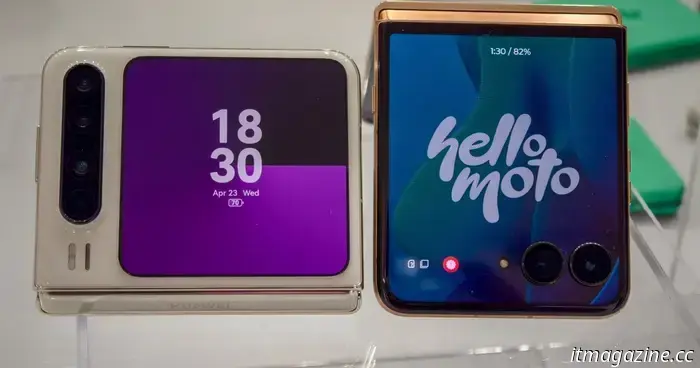
Meta's AI smart glasses with display features might disrupt Apple's plans in 2025.
Meta has achieved remarkable success with its camera-equipped smart glasses created in partnership with Ray-Ban. Initially designed for social media capture, these glasses have now transitioned into a platform for AI capabilities.
Reports indicate that Meta is now planning next-generation smart glasses that will incorporate a display unit. Notably, these could launch in the same timeframe typically associated with new iPhones and other Apple products in the fall. In contrast, Apple’s smart glasses initiative is said to be a few years behind.
According to a Bloomberg report, “Meta Platforms Inc. has set a significant product goal for 2025: an October release of premium smart glasses priced over $1,000 that feature a small display.” Although there may be minor delays, Meta's employees have reportedly been instructed to work urgently, which may include weekend shifts.
This projected October launch aligns with Meta’s annual Connect event, scheduled for September 17-18, 2025. Apple also introduces its next-generation iPhones in the same month, and this year could potentially bring a surprise with a headset as well.
What does the future hold for Meta’s smart glasses?
Prakhar Khanna / Digital Trends
Up to this point, Meta has not ventured into smart glasses with a display unit, but manufacturers such as Viture, TCL, RayNeo, and Xreal have been implementing this concept for years. One of the main benefits is that users can engage with content visually on a small display unit located behind the front lens, rather than relying solely on voice or audio inputs.
Importantly, the Meta smart glasses will feature a single display unit instead of individual OLED panels for each eye. “Unlike Meta’s existing spectacles, this version will allow users to access basic on-screen apps and view photos taken with the device,” the Bloomberg report states.
The monocular display is expected to be positioned in the lower right corner of the lens, designed for visual interactions through the right eye only. Users will navigate using hand gestures on the side arms, and display features will encompass map navigation, managing app notifications, reviewing pictures taken with the onboard cameras, and more.
Meta
On the software front, it’s anticipated that Meta’s forthcoming smart glasses will operate on a heavily modified version of Android, powered by a Qualcomm wearable processor.
Currently under development with the codename Hypernova, the next-gen Meta AI smart glasses may start at around $1,000, with prices potentially rising to $1,400. For context, the average cost for display-equipped XR glasses tends to be around $500.
Additionally, Meta is pursuing the Orion smart glasses, which will incorporate a built-in holographic display system. The company has already provided detailed previews of these glasses, but they are still several years away from release. In research, the company continues to advance true AR glasses within the Aria platform, aimed at scientific and industrial applications.


Other articles
 Huawei’s response to the Moto Razr Ultra 2025 makes me question who’s correct.
Should flip phones be considered a smaller smartphone or a mini tablet? I tested the Huawei Pura X and Razr Ultra 2025 to explore this question.
Huawei’s response to the Moto Razr Ultra 2025 makes me question who’s correct.
Should flip phones be considered a smaller smartphone or a mini tablet? I tested the Huawei Pura X and Razr Ultra 2025 to explore this question.
 Asus Vivobook 16 review: A step ahead of typical budget laptops
The Asus Vivobook 16, driven by Snapdragon X, offers a solid combination of affordability and practicality, while minimizing luxury features.
Asus Vivobook 16 review: A step ahead of typical budget laptops
The Asus Vivobook 16, driven by Snapdragon X, offers a solid combination of affordability and practicality, while minimizing luxury features.
 I utilized a complimentary application to resolve my main issue with macOS.
Apple has not incorporated a system-level clipboard into macOS. Maccy addresses this need perfectly, being open-source and entirely free if you choose.
I utilized a complimentary application to resolve my main issue with macOS.
Apple has not incorporated a system-level clipboard into macOS. Maccy addresses this need perfectly, being open-source and entirely free if you choose.
 Five of Southern Europe's fastest-growing scale-ups join TECH5's 'Champions League of Tech.'
Five exceptional scaleups from Southern Europe have made it to the finals of TECH5 — the "Champions League of Technology."
Five of Southern Europe's fastest-growing scale-ups join TECH5's 'Champions League of Tech.'
Five exceptional scaleups from Southern Europe have made it to the finals of TECH5 — the "Champions League of Technology."
 Top Bluetooth turntables of 2025: wireless record players evaluated by us
You don’t require costly equipment to enjoy vinyl records. By using a Bluetooth turntable, you can connect to your preferred wireless speaker. Here are our top picks.
Top Bluetooth turntables of 2025: wireless record players evaluated by us
You don’t require costly equipment to enjoy vinyl records. By using a Bluetooth turntable, you can connect to your preferred wireless speaker. Here are our top picks.
 If Clair Obscur: Expedition 33 is considered the greatest game of all time, here's the reason why.
Clair Obscur: Expedition 33 distinguishes itself by bending the rules in all the appropriate ways.
If Clair Obscur: Expedition 33 is considered the greatest game of all time, here's the reason why.
Clair Obscur: Expedition 33 distinguishes itself by bending the rules in all the appropriate ways.
Meta's AI smart glasses with display features might disrupt Apple's plans in 2025.
Meta's upcoming AI smart glasses may feature a display and operate on a tailored version of Android. They are expected to be released in October, coinciding with the iPhone launch period.
